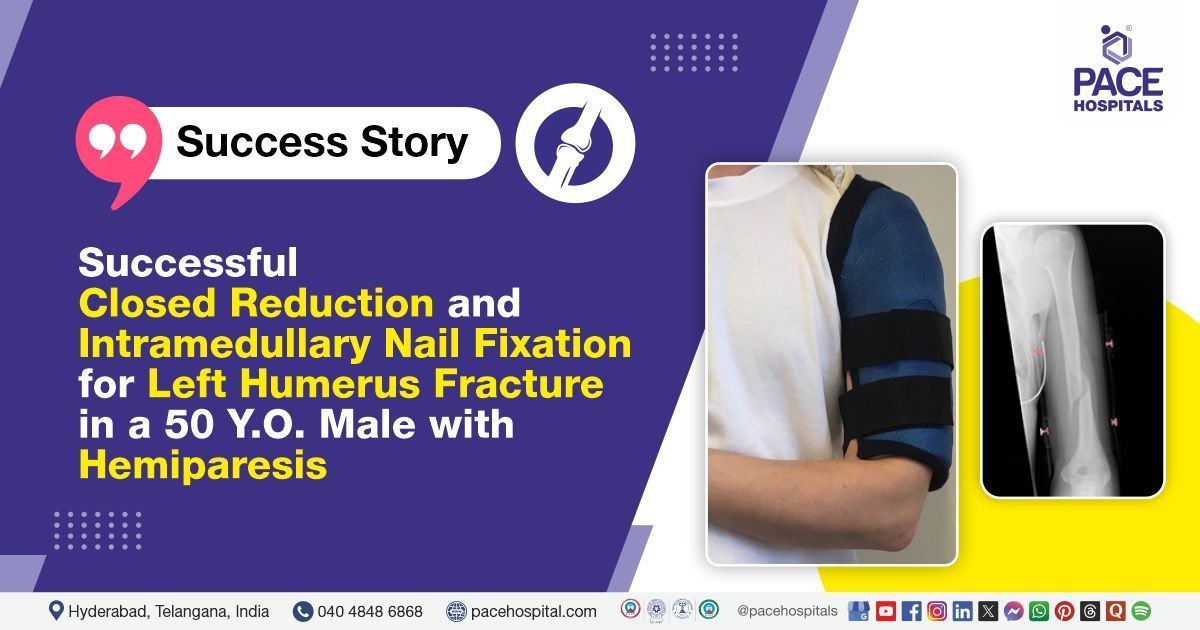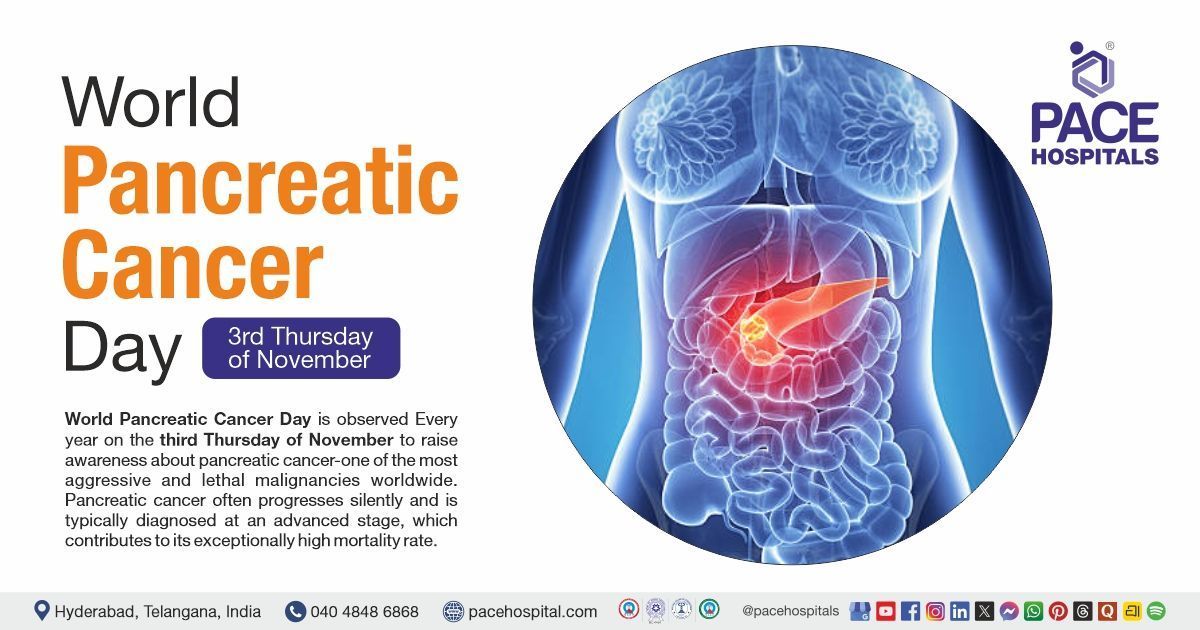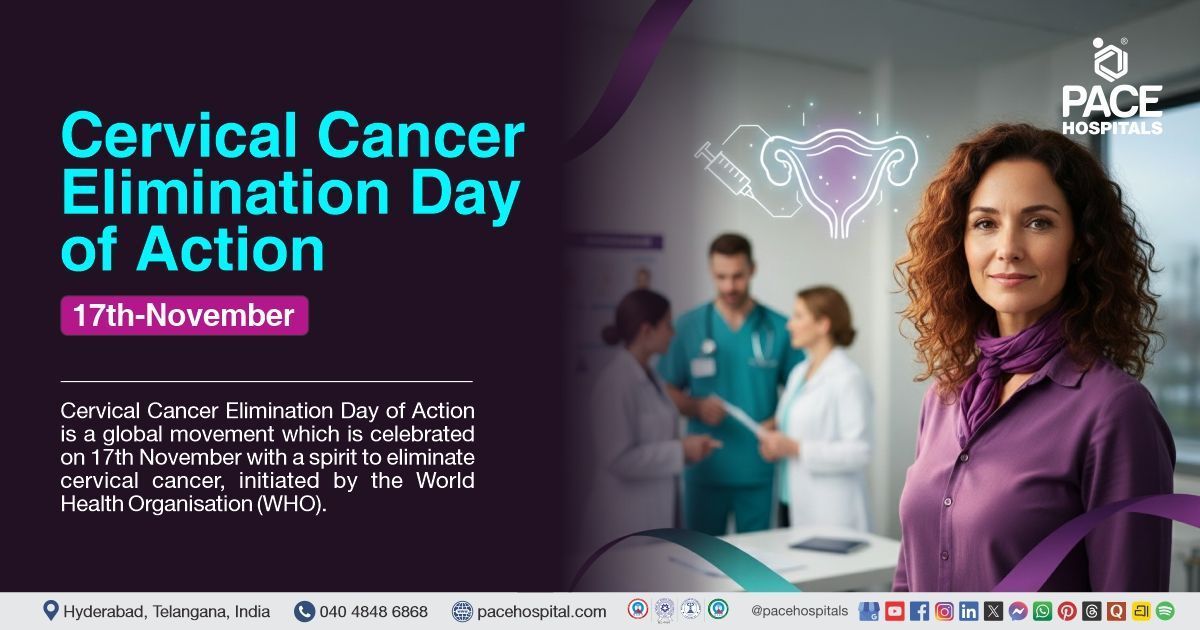Successful Closed Reduction and Intramedullary Nail Fixation for Left Humerus Fracture in a 50-Y.O Male with Hemiparesis
PACE Hospitals
PACE Hospitals’ expert orthopaedic team successfully performed a Closed Reduction and Internal Fixation (CRIF) with an Intramedullary Interlocking Nail (IMIL) on a 50-year-old male patient diagnosed with a post-traumatic spiral fracture of the left humerus shaft (OTA - 12 A1). The patient sustained the injury following a fall at home, which resulted in severe pain and restricted movement of the left arm. The surgical procedure aimed to stabilise the fracture, reduce pain, and restore functional mobility of the affected limb.
Chief Complaints
A 50-year-old male patient with a
body mass index (BMI) of 21.2 presented to the orthopaedic department at
PACE Hospitals, Hitech City, Hyderabad, with complaints of pain in the left arm and restricted shoulder movement following a fall at home. The symptoms significantly affected his ability to perform routine daily activities.
Past Medical History
The patient has a known history of left-sided hemiparesis and has been under regular neurological treatment for the condition.
On Examination
On examination, the patient was conscious, coherent, and well-oriented. Vital signs were stable, with normal heart rate, blood pressure, respiratory rate, and temperature. Local examination of the left upper limb revealed abnormal findings, including swelling, deformity, and tenderness over the distal one-third of the humerus, with palpable crepitus. The range of motion at the left shoulder and elbow was grossly restricted and associated with pain.
The left hand showed flexion of the fingers at the metacarpophalangeal (MCP) joints, suggestive of an old stroke. A flexion deformity was noted at the left elbow, and spasticity was present in the left upper limb. No distal neurovascular deficit (DNVD) was observed.
Diagnosis
Following the clinical examination, the orthopaedic team conducted a comprehensive assessment, which included a detailed review of the patient’s medical history, including known left-sided hemiparesis under medical management.
To confirm the diagnosis and evaluate the extent of the injury, an X-ray of the left arm (anteroposterior and lateral views) was performed, which revealed a spiral fracture of the mid-shaft of the left humerus (OTA – 12 A1). No distal neurovascular deficits were noted. Pre-operative 2D-Echo showed good cardiac function, with only mild diastolic dysfunction and no structural abnormalities.
Based on the confirmed diagnosis, the patient was advised to undergo Left Humerus Fracture Treatment in Hyderabad, India, under the care of the Orthopaedic Department, ensuring comprehensive management.
Medical Decision Making
After consultation with Dr. Anand Agroya, Consultant Orthopaedic Surgeon and cross consultations with Dr. S Pramod Kumar, Neurologist, Dr. Seshi Vardhan Janjirala, Cardiologist, and Dr. Pradeep Kiran Panchadi, Pulmonologist, a multidisciplinary team addressed the patient’s co-morbid condition of left-sided hemiparesis, spasticity, and cardiopulmonary fitness, which were thoroughly evaluated to ensure safe surgical management and recovery. A comprehensive evaluation was carried out to determine the most appropriate diagnosis and treatment plan for the patients. Based on the detailed clinical examination and imaging studies, including X-rays of the left humerus, surgical intervention was considered necessary.
It was determined that the patient had a displaced spiral fracture of the shaft of the left humerus (OTA 12 A1), which was causing significant pain, swelling, and restricted movement of the left shoulder. Closed Reduction and Internal Fixation (CRIF) with a titanium intramedullary interlocking nail was identified as the most suitable surgical intervention to stabilize the fracture and facilitate early rehabilitation.
The patient and his family were counselled regarding the diagnosis, the planned surgical procedure, its associated risks, and its potential to alleviate symptoms and improve his quality of life.
Surgical Procedure
Following the decision, the patient was scheduled to undergo Closed Reduction and Internal Fixation (CRIF) surgery in Hyderabad at PACE Hospitals with a titanium intramedullary interlocking nail of the shaft of the left humerus under the expert care of the Orthopaedic Department.
The procedure was carried out as follows:
- Preoperative Preparation: The patient was shifted to the operating room and placed under general anesthesia after complete preoperative assessment. The left arm was prepared and draped in a sterile manner. Intraoperative fluoroscopy (C-arm) was arranged for real-time imaging throughout the procedure.
- Closed Fracture Reduction: Closed manipulation was performed to realign the fracture fragments of the left humerus. Fluoroscopic guidance was used continuously to ensure anatomical alignment.
- Entry Point and Canal Preparation: A small incision was made near the proximal humerus to access the intramedullary canal. The entry point was created using a bone awl, and the canal was prepared to accommodate the intramedullary nail.
- Insertion of Intramedullary Nail: A Titanium Intramedullary Interlocking Nail (PDL 6 * 240 mm) was inserted through the prepared entry point into the canal, with fluoroscopic imaging confirming correct placement and fracture alignment.
- Locking Screws Fixation: Proximal and distal locking screws were placed using a targeting jig to ensure rotational and axial stability. The positioning was verified with C-arm fluoroscopy.
- Final Check and Wound Closure: Final imaging confirmed satisfactory implant placement and fracture alignment. The surgical site was irrigated, and the wound was closed in layers using appropriate sutures. A sterile dressing was applied, and the left arm was immobilised.
Postoperative Care
The postoperative period was uneventful. The patient was monitored in the recovery room for a few hours and later shifted to the ward in stable condition. On postoperative day 1, the surgical dressing was done, and the wound appeared clean and dry. An X-ray was done, which showed satisfactory reduction with the implant in situ. During his hospital stay, he was managed with intravenous antibiotics, analgesics, and supportive care. The physiotherapy team assisted the patient with bed mobilisation and helped him to sit up. The patient was discharged in a hemodynamically stable condition with prescribed medications and instructions for ongoing care, and the need for additional Botox injection was discussed with the family.
Discharge Medications
Upon discharge, the patient was prescribed oral antibiotics to prevent infection and analgesics for effective pain management. Anti-inflammatory medications were included to reduce swelling, along with gastric protectors to safeguard against stomach irritation. Neuro-muscle relaxants were administered to manage spasticity and hemiparesis.
Advice on Discharge
The patient was advised to continue using an arm pouch for immobilization until further instructions were given. Care was emphasized to keep the surgical dressing dry and intact. Gentle finger movements of the left hand were recommended to promote circulation and prevent joint stiffness.
Emergency Care
The patient and his family were informed to contact the emergency ward at PACE Hospitals in case of any emergency or development of symptoms such as bleeding, shortness of breath, severe pain, or fever.
Review and Follow-up Notes
The patient was advised to return for a follow-up visit with the Orthopaedic Doctor in Hyderabad at PACE Hospitals after five days of discharge for wound dressing and clinical evaluation. Immediate review was recommended in case of fever, discharge from the wound site, or the appearance of blebs over the left arm.
Conclusion
This case highlights the successful management of a left humerus fracture through closed reduction and Internal Fixation (CRIF) with Intramedullary Interlocking Nail (IMIL). The patient had an uneventful postoperative recovery and was discharged in stable condition. Proper follow-up and adherence to post-operative care were advised to ensure complete functional recovery.
Role of an Orthopaedic Surgeon in Fracture Fixation in Hemiparetic Limbs
In patients with hemiparesis and spasticity following a stroke, the functional demand of the affected limb is often reduced, but achieving proper anatomical union in the event of a fracture remains crucial. An experienced
orthopaedic doctor/orthopaedic surgeon ensures that successful fixation not only prevents deformity, pain, and malunion but also facilitates transfers, supports self-care activities such as dressing and maintaining hygiene, and helps preserve limb symmetry. Proper healing also reduces caregiver burden and prevents the existing disability from worsening. Even if fine motor recovery may be limited, stabilising the fracture is essential to maintain comfort, function, and overall quality of life.
Share on
Request an appointment
Fill in the appointment form or call us instantly to book a confirmed appointment with our super specialist at 04048486868











